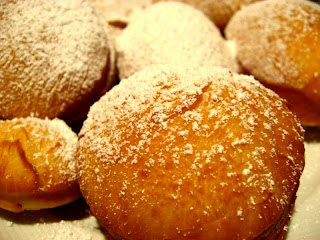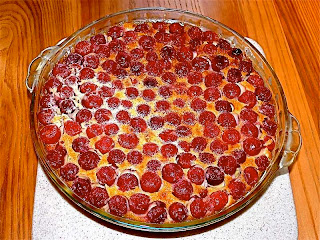Variations of fried dough can be found across cuisines internationally; however, the origin of the term beignet is specifically French. In the U.S., beignets have been popular within New Orleans Creole cuisine and are customarily served as a dessert or in some sweet variation.
They were brought to Louisiana in the 18th century by French colonists, from “the old mother country”, and became a large part of home-style Creole cooking, variations often including banana or plantain – popular fruits in the port city.
Today, Café du Monde is a popular New Orleans food destination specializing in beignets with powdered sugar (served in threes), coffee with chicory, and café au lait. Beignets were declared the official state doughnut of Louisiana in 1986.
The tradition of deep-frying fruits for a side dish dates to the time of Ancient Rome, while the tradition of beignets in Europe is speculated to have originated with a heavy influence of Islamic culinary tradition.
 | The term beignet can be applied to two varieties, depending on the type of pastry. The French-style beignet in the United States has the specific meaning of deep-fried choux pastry. Beignets can also be made with yeast pastry, which might be called boules de Berlin in French, referring to Berliner doughnuts which have a spherical shape (i.e. they do not have the typical doughnut hole) filled with fruit or jam. In Corsica, beignets made with chestnut flour (Beignets de farine de châtaigne) are known as fritelli. |
| From wikiHOW |
| Recipe For Beignet |
1 egg 1 cup (236 ml) lukewarm water 1/4 cup (59 ml) granulated sugar 1/2 tsp. (2.5 ml) salt 2 tbsp. (30 ml) softened butter | 1/2 cup evaporated milk 4 cups bread flour or all-purpose flour 3 tsp. (15 ml) instant active dry yeast Vegetable oil Powdered sugar |
Beat 1 egg, warmed to room temperature. Add 1 cup (236 ml) of lukewarm water and 1/4 cup (59 ml) granulated sugar to the beaten egg in a bowl or stand mixer. Mix in 1/2 tsp. (2.5 ml) salt and 2 tbsp. (30 ml) of softened butter. Pour in 1/2 cup evaporated milk, 4 cups bread flour or all-purpose flour and 3 tsp. (15 ml) of instant active dry yeast. Beat the ingredients on medium speed until the dough is smooth.
Put the dough into a lightly oiled bowl and cover with plastic wrap. Refrigerate for 3 to 4 hours or overnight. Roll the dough on a lightly floured surface until it is 1/4 inch (.6 cm) thick. Cut the dough into 3 inch (7.6 cm) squares. Heat vegetable oil in a deep fryer or large pan until it reaches 350 degrees F (176 degrees C).
Fry 2 to 3 pieces at a time until they puff and brown on the bottom side. Turn them over using tongs and cook until the other side turns the same shade of brown. Remove your homemade beignets and place them on paper towels. Sprinkle with powdered sugar and serve hot. This beignet recipe makes approximately 18 to 24 squares.
The dough can be made ahead and refrigerated for up to a week. Punch the dough down when it rises. The dough can also be frozen. Just make sure you roll it out and cut the squares prior to freezing.
Text Credits: Wikipedia || wikiHOW
Image Credit: wikimediaCommons

















